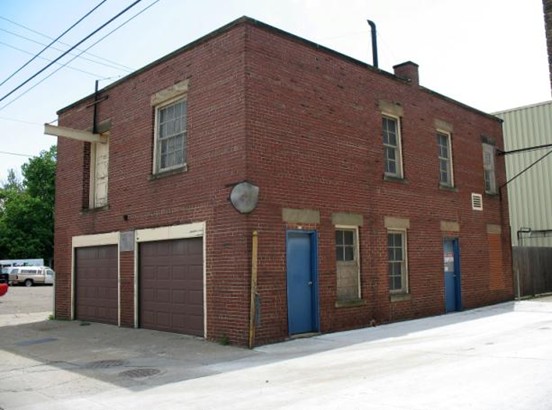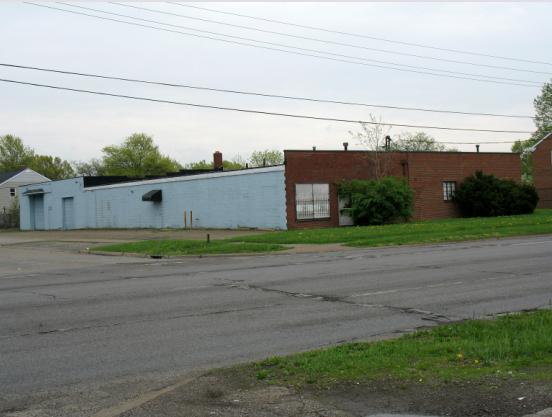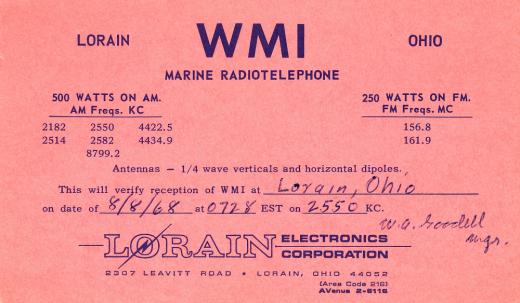
Home Page
LEC WMI Recollections of Ken Bobel, WA8YJW
Lorain Telephone Corp. was the parent of Lorain County Radio Corp. (LCRC) which dates from 1928 and which changed its name in the 1960s to Lorain Electronics (LEC). I worked for Paul Romoser in the Lorain Electronics Engineering. Dept. as an engineering technician from 1967 to 1971. During this time I was also an engineering student so I worked around my school schedule and full time during breaks.
The building shown below is where Lorain County Radio Corp. the owner / operator of WMI was founded in 1928. This building is located directly behind the then Lorain Telephone Co. offices and main exchange(s). The two companies shared the same address of 203 W. 9th St. Lorain, OH. The Principals of the telco were the founders of LCRC and held a majority stock ownership in LCRC and in LEC right up to the sale of the Co. to Oakmont Marine Corp. in 1977. From about 1932 to late 1964 LORAIN brand shipboard and shore radios (both AM Phone later FM Phone) and related equipment were designed and manufactured in this building. Today the building houses a natural gas powered back-up generator and controls for the adjacent telco, now known as Century Tel of Ohio.

203 W. 9th St. Lorain, OH - 2009 Photo by Ken Bobel
By late 1964 LCRC had expanded to include Sales, Installation, and Service of DECCA (a premium German brand) navigational radar, ARKUS carbon arc spot/search lights, auto pilots, Loran, and other navigational equipment. Out of space, the company moved to a larger facility (shown below) about a mile away at 2307 Leavitt Rd. in Lorain. The building faces Leavitt Rd. The side street is W. 23rd St. The company also owned an additional parking lot / storage area across the side street (out of the picture on the left). The building was previously owned by The Duffin Mfg. Co., a machining operation. As a result, some areas of the concrete floor were saturated with spilled/splattered cutting oil and it leached out for years. Along with the move in late 1964 / early 1965 it was determined a name change was necessary to reflect the expanding business and Lorain Electronics Corp. (LEC) came into being. However, there was no change in ownership. The Leavitt Rd. building was occupied by LEC up until the end of the Oakmont Marine liquidation of the Co. in 1986.

2307 Leavitt Road, Lorain, OH - 2009 photo by Ken Bobel
About the time of the move to Leavitt Road manufacturing started on the Lorain MM14 line of FM radios (MASTR Marine 14 Channel) assembled from GE MASTR PRO modules and circuit boards. Receiver strips were specially ordered wide-band units # ER-41B, not the A version. These units replaced the company's earlier offering of 8 channel GE Progress Line gear. (Note that the TPL vintage equipment was passed over and for good reason!)
At one time numerous test antennas sprouted from the roof of the Leavitt Road building, including an HF long wire, and a DECCA radar scanner (i.e. a rotating dish) licensed for service purposes. The property bordered on a low-income housing project and residential turn-over was somewhat high. Occasionally, a new local would ask if we were connected with the CIA or some other secret gov. function, referring to all the antennas. Occasionally we’d answer "Yes" and leave at that.
After the LEC move to Leavitt Road the telco took the old 9th Street building (top photo) back, but LEC still had ties to it. The growing telco needed to add more trunk lines to two of its outlying exchanges in the suburbs, the quickest way was to install short hop microwave gear. An 80’ MW tower was installed on the west side of the building along with GTE/ Lenkurt MW gear. Since most LEC service techs were FCC licensed, LEC was contracted to maintain the MW gear (as an FCC license was required) over it’s service life.
In 1969 the Lake Carriers Association (LCA) wanted to avoid moving all the ship gear to narrow band. There was a Law Suit and the LCA wanted LEC to prove WB better than NB. The LEC part of the Wide Vs. Narrow tests mentioned in the suite was run from the Leavitt Road site in the Engineering Dept. under the supervision of Chief Engineer Paul Romoser, using the STA Callsign Experimental license KA2XPN (or was it WA2XPN?). The FCC prevailed and the marine changeover to narrow band vhf was in 1970.
The Lorain County Radio Corp. (LCRC) was a GESS (GE two-way authorized Sales and Service) and it bought the FM gear used for the marine conversions. It also developed a tidy Land Mobile business, both public safety and commercial business. In the second photo above the smaller overhead door was the Mobile Dept. installation bay. The large door was the Warehouse/shipping/receiving area. The telco contracted it’s mobile telephone operations to LCRC/LEC. The mobile telephone terminal was KQA649. The very first mobiles phones were conventional low-band GE two-can transmitter/receiver combos a.k.a. turkey roasters. Operation was half duplex, voice call / ptt on the original low band FCC assignment of channels ZA and ZR - 35 MHz station xmit with 43 MHz mobile xmit. After about 1952-3 high band channels were authorized and LEC got channel JR - 153.810 MHz station xmit. JR was full duplex and the GE terminal and antennas were installed on WMI’s tower. The WMI marine station operators were also the mobile operators. Initial JR operation was MTS with then newly introduced GE vibrator Progress Line mobiles, MA/E33’s PTT with Secode electro-mechanical ringers. Quickly replaced by GE Progress Line DTO3’s, an application specific (read: heavily modified) "T" power, full duplex, 5 channel Prog Line in a standard 14" case w/Secode transistorized decoder for selective ringing.
In addition to the WMI main site on Meister Road there was also, a "West Lot." - a receiver site in small concrete block house and a 8MHz antenna array - a 5 wire Yagi on 6 poles (made from 12) tied together with iron bands and aimed at Lake Superior. It was located on the west side of Oak Point Rd., about today's 4900 Block. This site is 1.4 mi. SW of the station location as checked via USGS Topo map. It was 1000' ft. off the road and a difficult hike through the reclaiming thicket when I visited it several times over 35 years ago. It was decommissioned about the time VHF FM was taking off (1949/50?). (Webmaster Note: This decommissioning date for is much earlier than other information indicates.) A current housing development has erased all traces of the site.

I treasure this QSL card from WMI's vibrant years.
After the Oakmont sale in 1977 (details follow) the WMI Meister Road site was decommissioned in late 1978 or early 1979. This was possible because, by this time, HF SSB operation was declining rapidly, and it was determined that the Great Lakes VHF System along with the tiny remaining HF traffic could all be remote controlled from a corner of the Leavitt Road building. The HF station equipment was moved to a South Amherst, OH site. The WMI station building and towers were gutted and anything salvageable was offered for sale and what wasn’t sold was scrapped for minimal cash. The WMI property was then sold as it occupied acres and acres of prime development real estate. A housing development now occupies the part of the site immediately off Meister Road, but the rear area where the VHF towers were was still undeveloped in 2009.
WMI's last hurrah was from the remote site at So. Amherst, OH. This site was in Henrietta Twp. about 1 mi. west of the village limits and on the south side of St. Rt. 113, 1000' east of the intersection of St. Rt. 113 and Gifford Rd. - 41 20.650' N, 082 17.140' W. This installation was remote controlled from 2307 Leavitt Rd. I recall the antenna was a huge rotatable Log Periodic Yagi on 60-70' of massive tower. The tower/rotor/antenna was taken down from the original Meister Rd. site. There may still be a UHF community repeater or two using the S. Amherst site. Also, replacing the big Mister Road VHF towers, was a small TV tower (50’?) installed on the south side of the Leavitt Road building for local VHF work.
After
the 1977 sale to Oakmont, the new owner brought in it's own people,
with
little radio/marine knowledge and started gutting Co. assets and taking
out the cash - the true purpose for the sale
of the company. Long time LEC employees (the ones left who
hadn't
already taken their retirement and cashed out) saw the handwriting on
the wall and also got out. By 1986 there wasn’t
much left to sell off, only a few outsider Oakmont employees were left
and their mission was to shut down operations and turn anything that
could be sold into whatever cash the traffic would bear. An
open
house "final" sale was held. Any gear/spare parts/test
equipment
still left was piled on pallets and offered in lots. Cash and
carry. Will the last person out, please turn off the
lights?
WMI still lives on if only on my Ohio Lake Erie
commemorative license plates. On the left side of the plate
is a
logo of the Marblehead, OH lighthouse - a Lake Erie Historical
Landmark. I thought "WMI" would be a proper vanity "license number" for
Lake Erie plates. (The State of OH doesn't consider three "initials" a
radio call sign.)
--------------------------
Ham Note: The first full-time 2m repeater in Ohio, W8GET, utilized a Progress Line Rx from a Lorain PM-8 marine unit and a Pre-Progress MC261 exciter driving a GE 200w Amplifier - a pair of 4-125s with 866 mercury vapor rectifiers. All the gear was donated by LEC hams.
-------------------------
Ken Bobel, WA8YJW
March 2010
Reconstruct Ken's E-Mail address: wa8yjw-at-centurytel-dot-net